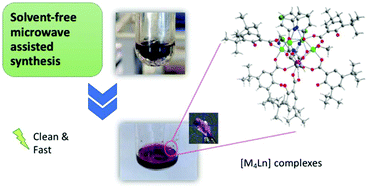Microwave assisted synthesis of heterometallic 3d–4f M4Ln complexes†
Abstract
In this paper we describe the synthesis and magnetic properties of a series of 3d–4f complexes of general formula [M4Ln(OH)2(chp)4(SALOH)5(H2O)(MeCN)(Solv)] (Solv = MeOH, MeCN, H2O; chp stands for deprotonated 6-chloro-2-hydroxypyridine (C5H3ClNO), SALOH stands for monodeprotonated 3,5-ditert-butylsalicylic acid (C15H21O3)) obtained by a solvent-free microwave assisted synthesis method. The Ni(II) complexes (Ni4Gd, Solv = MeOH; Ni4Dy, Solv = MeCN) are not SMMs in the absence of an applied dc field. The replacement of Ni(II) by Co(II) (Co4La, Solv = MeOH; Co4Gd, Solv = H2O; Co4Gd-MeCN, Solv = MeCN; Co4Tb, Solv = MeOH; Co4Dy, Solv = H2O) results in improved SMM properties.



 Please wait while we load your content...
Please wait while we load your content...